In the night between Saturday
3rd and Sunday 4th August, 1974, in Italy, a bomb
exploded on coach 5 of the 1486 Rome-Munich express train, known
as "Italicus", causing 12 victims and 48 injured.
The investigations were disturbed by innumerable red herrings,
even by state bodies, and in the end this crime went unpunished,
despite the fact that the responsibility of the neo-fascists of
Ordine Nuovo group clearly emerged.
The premises
The year 1974 was
particularly active for fascist subversion in Italy, which carried
out its "strategy of tension", a long sequence of terrorist
acts which was meant to prepare a popular reaction in favor of
a coup which would have established an authoritarian right wing
regime. The coup was planned in the spring-summer of 1974, with
the support of "National Socialist" officers stationed
in the north-east, as reported to the investigating judge of Bologna
by the neo-fascist Sergio Calore, reporting what was told to him
by the other fascist terrorist Paolo Signorelli.
From January to August 1974, 42 attacks attributable to black
terrorists took place, starting with January 29th,
1974, in which a bomb failed to hit the Freccia del Sud train.
A few days later, on February 9th, another unexploded bomb was
found on a freight train heading from Taranto to Syracuse. Finally,
on April 21st, a terrorist attack seriously
damaged the Florence-Bologna railway line at Vaiano, in the province
of Prato: a bomb exploded on the tracks and interrupted the railway,
but this also stopped the next train that was due to pass, avoiding
a massacre.
Then the Brescia massacre
occurred: on May 28th a bomb exploded in the square
piazza della Loggia in Brescia,
Lombardy, during a trade union demonstration, killing 8 people
and wounding 102.
Two days later, on May 30th, on the Pian del Rascino plateau,
in the province of Rieti, the fascist Giancarlo Esposti died in
a shootout against the Carabinieri police, while preparing, according
to several of his comrades, to move to Rome with the plan of carrying
out an attack against the President of the Republic Giovanni
Leone, shooting him dead during the Republic Day parade
on June 2nd.
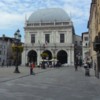
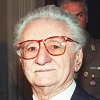
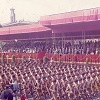
The train
The Italicus train
was scheduled to depart at 8:35pm on August 3rd from Roma Tiburtina
station, headed to Munich, Germany,
where, according to the official
timetable of the Ferrovie dello Stato (Italian State Railways),
it was scheduled to arrive on the morning of August 4th
at 10:05am. It had actually departed seven minutes late, at 8:42pm,
it had stopped at Chiusi-Chianciano
Terme station and then for ten minutes at Florence
Santa Maria Novella, departing again at 0:33am, 23 minutes
late, and headed for Bologna, where it had to arrive at 1:24am
and depart at 1:50am. The train had seventeen coaches, of which
nine were passengers coaches, three sleeping cars, two couchette
cars, one postal coach and two car-carrier wagons. The first was
a couchette coach followed by a first class one, bound for San
Candido, followed by a second couchette car for Brenner, then
three coaches for Munich, of first and second class and couchettes
passengers, then a baggage car, two coaches for Venice, five for
Calalzo and at the end the two car-carrier wagons. At the departure
from Florence the train had a total of 49 first class passengers
and 293 second class passengers on board.
Coach 5 was bound for Munich, belonged to the German railways
(DB - Deutsche Bundesbahn) with serial number AB3840063/8, and
was part of a batch of forty, built between 1936 and 1939 by Dentz
and DWV of Berlin. Due to its age it was only used in internal
service, except in the summer, when it was also used for international
service. The coach had three first-class compartments, with 18
seats, and five second-class compartments, with 40 seats. (Sentence Italicus
- Preliminary Investigation Judge Vella, from https://4agosto1974.wordpress.com/)
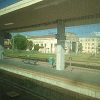
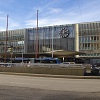
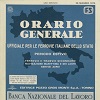
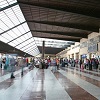
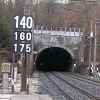
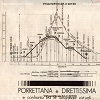
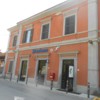

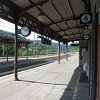
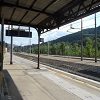
The bombing
The explosion occurred
at 1:17am in the third compartment of the fifth coach, first class,
towards the head of the train. while this was 100 meters (300
ft about) from the exit towards
Bologna of the Grande
Galleria dell'Appennino (Great Apennine Tunnel), 18.507 km
(11.5 Mi) long, which at the time was the longest railway tunnel
in Italy. The train continued by inertia to the station
of San Benedetto Val di Sambro - Castiglione dei Pepoli, which
is located immediately at the exit
of the tunnel.
The two police officers on duty at the San Benedetto station,
direct witnesses of the massacre, recount: "Suddenly the
tunnel from which the train was supposed to emerge was lit up
as day, the mountain shook, then a deafening roar came. The convoy,
by inertia, has arrived right in front of us. The flames were
very high and dazzling ... we could not do anything because the
external metal sheets were incandescent ...". A witness
of the massacre narrates: "The coach torn apart by the
explosion seems to fry, the sprays of the foaming agents bounce
off it. The sweetish and nauseating smell of death hovers over
the whole area". .
Below are the photos taken by the Fire Fighters during their intervention.
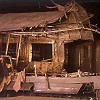
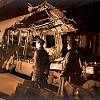
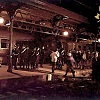
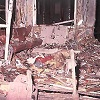
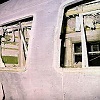
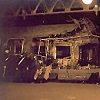
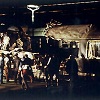
The bomb
No trace of the explosive
from the attack was found on the remains of the train, on the
walls of the tunnel and on the objects recovered at the site of
the massacre. So there are only hypotheses about the composition
of the bomb. The experts believed that the item was composed of
2.0-2.5 kg of amatol, an explosive mixture of trinitrotoluene
(TNT) and ammonium nitrate (NH4NO3), together with thermite, an
incendiary mixture of methyl alcohol (CH3OH)
and ferric oxide (Fe2O3), which caused the fire which
produced very high temperatures in coach number 5, and traces
of which were found on the tunnel vault.
The bomb was probably activated by a timer, of which fragments
were found, prepared by modifying a Peter brand alarm clock, built
in 1973 by the Peter-Uhren GmbH company of Rottweil, in the Federal
Republic of Germany, so as to use it as an "electromechanical
switch, controlled by time from the alarm bell device”.
The victims
The fascist bomb killed
twelve people: Nunzio Russo
(49 years old) a State Railways lathe turner, his wife Maria
Santina Carraro née Russo (47 years old) and their
son Marco Russo (14 years old) all residing in Merano (province
of Bolzano), Wilhelmus Jacobus Hanema (20 years old) from Kerkbuurt
(Netherlands), Raffaella Garosi (22 years old) from Grosseto,
which graduated 15 days before in ancient literature, Tsugufumi
Fukuda (32 years old) from Maebashi, Gunma prefecture, Japan,
Herbert Kontriner (35 years old) German worker from Tuttlingen,
Nicola Buffi (51 years old) from Florence, Elena Donatini (58
years old) from Florence, Elena Celli (67 years old) retired from
Rome, Antidio Medaglia (70 years old) an INAM (national health
fund) official from Perugia, and the railwayman Silver Sirotti,
24 years, ticket inspector of the State Railways.
Silver
Sirotti
One of the twelve
victims of the Italicus massacre, the State Railways officer Silver Sirotti, born in Forlì
on September 2nd, 1949, was on the Italicus train
but was not affected by the explosion because he was in a different
coach from the one in which the bomb had been placed. Despite
this Sirotti rushed into coach 5, shouldering a fire extinguisher
to help the wounded, but was killed by the very high temperature
developed by the fascist bomb.
The testimony of two police officers on duty at the San Benedetto
station recounts: «Standing in the center of the coach
there was a railwayman, his skin was black covered with horrible
red spots, he was trying to move something. Under him there must
have been a person entangled. "Come away from there",
we shouted at him, but just at that moment a flash hit him making
him fall crumpled to the ground».
Sirotti however managed to save at least one person, the young
Marisa Russo, whose parents and younger brother were among the
victims of the massacre. Silver had thrown himself on her protecting
her from a blaze of fire. (Bedeschi)
Sirotti had been hired for three months and didn't even have a
uniform, just a hat, and he shouldn't have been on duty the night
of the massacre, but due to an exchange of favors between colleagues
he found himself instead on the Italicus.
On May 14th, 1975 Silver Sirotti was decorated
with the gold medal for civil valor with this motivation: «Ticket
inspector on duty, on the occasion of the criminal attack on the
Italicus train, he did not hesitate to throw himself, equipped
with a fire extinguisher, into the coach where the explosion occurred
to rescue the passengers of the burning coach. In a noble attempt,
he sacrificed his young life to the highest ideals of human solidarity.
Shining example of exceptional contempt of danger and unconditional
attachment to duty, pushed to the extreme sacrifice. To memory.».
Forlì, the birthplace of Silver Sirotti, has dedicated
a park and a street to him, and other cities in Romagna, such
as Cesena, Ravenna and Forlimpopoli, have also named a street
after him, while in Rimini the park
in front of the train station was dedicated to him.
At the Bologna railway station, the scene of the massacre of August
2nd, 1980 (see my
webpage), a monument
to Silver Sirotti has been placed in a small garden, adjacent
to platform 1.
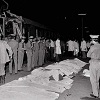
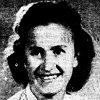
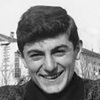
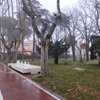
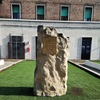
After
the massacre
The Italian democratics
immediately reacted to the massacre with demonstrations, both
spontaneous and organized. The general strike was proclaimed and
a joint trade unions demonstration was held in Bologna on August
6th, 1974 in Piazza Maggiore.
On August 9th, 1974, the public
funerals were held in the same Piazza Maggiore in Bologna
for ten of the victims of the massacre, in which an immense crowd
took part, which strongly contested the authorities who intervened,
in particular those identified as contiguous to the fascists,
such as the President of the Republic Giovanni Leone, elected
in 1971 thanks to the votes of the Movimento Sociale Italiano,
the neo-fascist party, the Prime Minister Rumor, criticized for
his ambiguous role as head of government and interior minister
during the 1969 massacres and the Secretary of the Christian Democracy
Amintore Fanfani.
Instead, the banner of the municipality of Marzabotto, a martyr
city of the Nazi massacres of July 1944, was applauded.
The official speech was given by the mayor of Bologna Renato
Zangheri, one of the leaders of the Italian Communist Party,
who harshly condemned terrorism and asked for greater attention
and incisiveness in the investigations., and also the Secretary
General of the Party, Enrico Berlinguer,
took part in the funeral.
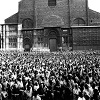
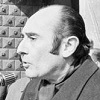

The investigations
The day after the
massacre, August 5th, a typewritten flyer was found
in a telephone box in the Porta San Mamolo area in Bologna in
which the section entitled to Drieu de la Rochelle of the fascist
organization "Ordine Nuovo" claimed the attack as revenge
for the death of Giancarlo Esposti and claimed to be able to strike
where and when he wanted. It was later discovered that the author
of the claim was a fascist militant, but with problems of mental
imbalance.
Five days after the massacre, a lotto office keeper from Rome
testified of a phone call overheard a few days before the massacre
in her shop, in which a girl spoke of bombs that were ready, of
a train to Mestre, of a car and passports to cross the border.
The girl was identified as Claudia Ajello, and she turned out
to be a collaborator of the SID (secret service of the time),
also infiltrated into a section of the Communist Party. When questioned,
she explained the phone call was a simple chat with her mother
in which a trip was planned, but she was indicted for perjury.
On December 15th, 1975, three inmates of the Arezzo
prison, Aurelio Fianchini, Felice D'Alessandro and Luciano Franci,
escaped, with the intention of bringing Franci before the press
to make him confess to the massacre, in exchange for help to expatriate.
During the escape Franci and D'Alessandro changed their minds
and only Fianchini made statements to the police, recounting that
during their joint detention Franci had told him that the massacre
was the work of Mario Tuti, who had supplied the explosive, of
Piero Malentacchi, who he had placed the bomb on the train in
the Florence Santa Maria Novella station, and of Franci himself,
who worked in the station post office, and so acted as a lookout.
The device had been assembled by Malentacchi who had acquired
specific expertise in explosives during his military service.
During the various trials that followed, numerous confirmations
emerged of Franci's statements, referred to by Fianchini, which
identified Tuti, Franci and Malentacchi as the perpetrators of
the attack, together with Margherita Luddi, Franci's fiancée.
The four, indicted in 1980, were also under investigation for
the attack on the Terontola train station on January 6th,
1975, for which Franci was in prison at the time of the escape.
Franci and Malentacchi were arrested on January 22nd,
1975; two days later three police officers went to Empoli, near
Florence, to search Tuti's house. The fascist killed two and seriously
wounded a third with machine gun shots and fled, but was captured
the following July in France.
The case of the attack on Italicus train saw the heavy involvement
of the secret services and the deviated Masonic lodge P2, to which
Mario Marsili also belonged, the public prosecutor of Arezzo in
charge of investigating the Terontola attack, who was, among other
, the son-in-law of Licio Gelli, grand master of the lodge and
string-puller of many political and illegal traffics affairs.
In the Majority Report of the Parliament Board on the P2 Masonic
lodge you can read: "it can be affirmed that the investigations
carried out by the Bologna judges, just as they were the basis
for an acquittal sentence for insufficiently proven personal responsibilities
of the defendants, also constitute a very solid basis, when integrated
with further elements in the possession of the Board, to affirm:
that the Italicus train massacre can be ascribed to a neo-fascist
or neo-nazi terrorist organization operating in Tuscany; that
the P2 lodge carried out the work of instigating the attacks and
financing of the groups of the Tuscan extra-parliamentary right;
that the P2 Lodge is therefore seriously involved in the Italicus
massacre and can even be held responsible for it in non-judicial
but historical-political terms, as an essential economic, organizational
and moral background".
The trials
The first investigation
ended on August 1st, 1980 with the indictment of
Tuti, Franci, Malentacchi, Luddi and, for other crimes, of four
more persons. The Court of Assizes of Bologna on July 20th,
1983 acquitted Tuti, Franci, Malentacchi and Luddi due to lack
of evidence.
On December 18th, 1986, the Assize Court of Appeal
of Bologna annulled the acquittals of Tuti and Franci and sentenced
them to life imprisonment as perpetrators of the Italicus massacre.
Malentacchi and Luddi were instead acquitted.
On December 16th, 1987, the Court of Cassation,
presided over by Corrado Carnevale, known as the "sentence
killer", for having annulled many other convictions involving
right-wing politicians and terrorists, annulled the convictions
of Tuti and Franci.
The new trial before the Court of Appeal of Bologna acquitted
Tuti and Franci, with a sentence that was definitively confirmed
by the Court of Cassation on March 24th, 1992.
The time
of the massacre
On many sites we read
that the bomb was planned to explode in the middle of the great
tunnel of the Apennines, making hundreds of victims, but the train
was twenty-three minutes late and therefore the bomb exploded
almost at the exit of the tunnel, and the shock wave found an
escape outside the tunnel. Actually if the train had been on schedule
it would have been much further on, beyond the tunnel, almost
in Bologna (arrival was scheduled for 1:24am), and so it can be
hypothesized that the fascists who placed the bomb had calculated
blowing it up in the Bologna station, involving other trains,
but at that time of night the effect wasn't sure.
Otherwise, another hypothesis can be made, given that it has been
ascertained that the bomb was placed under a seat in coach 5 while
it was at the Florence station. In this case the delay was known
to the terrorists, and they would have set the timer in Florence
calculating the 23 minute delay, to cause the explosion in the
great tunnel of the Apennines, but the train, after leaving Florence,
had made up for three minutes, and so it was almost out of the
tunnel.
However, it must be considered that a little more than ten years
later, on December 23rd, 1984, on another train, the
rapid 904, a bomb exploded, this time placed by the mafia, still
in the Great Tunnel of the Apennines, still in the direction of
Bologna, but after the Tuscan station of Vernio, which is located
at the other end of the tunnel with respect to that of San Benedetto
Val di Sambro. The explosion took place almost in the middle of
the tunnel and caused 16 victims and 266 injuries, the number
of deaths was therefore of the same order of magnitude compared
to the Italicus massacre, which suggests that if in 1974 the bomb
had exploded in the center of the tunnel probably the outcome
would have been the same.
In any case, 12 or 16 dead are such a horrific number that it
doesn't allow one to think that "it could have been worse",
and in any case the claim of Ordine Nuovo did not express a trace
of disappointment for the failure of the attack: the effect intended
by the terrorists, fascists in 1974 and mafiosi in 1984, had in
any case been reached.
Memory
In 1976 the singer-songwriter
from Bologna Claudio Lolli (1950-2018) in
the album "Ho visto anche
degli zingari felici" ("I also saw happy
gipsies") published the song "Agosto"
("August") (listen)
inspired by the Italicus massacre and "Piazza, bella
piazza" ("Square, beautiful square")
(listen)
dedicated to the funerals of the victims in piazza Maggiore, in
Bologna (see
page on the website "Canzoni contro la guerra"
i. e. "Songs against the war").
In the film "Strane
storie" ("Strange Stories") by Sandro
Baldoni, of 1994, in the final sequences the characters, having
got off a train in an abandoned station, pass
next to carriage number 5 of the Italicus, a caption
explains: "I rottami del vagone dell'Italicus, distrutto
da una bomba anonima il 4 agosto 1974, sono abbandonati in un
prato, tra i rifiuti, vicino alla stazione di Bologna"
("The wreckage of the Italicus coach, destroyed by an
anonymous bomb on August 4th, 1974, is abandoned in a meadow,
among the rubbish, near the Bologna station").
On the square in front of the San Benedetto Val di Sambro - Castiglione
dei Pepoli station, a monument
was erected in memory of the massacre, made up of part of the
wreckage of coach 5.

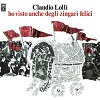
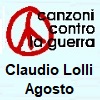
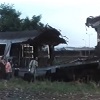
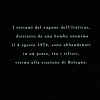
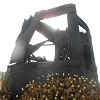
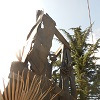
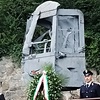
Bibliographic references:
BEDESCHI
Giacomo (2020) “Mio fratello morì sull’Italicus.
Vogliamo la verità sulla strage”. Corriere Romagna, August 3rd,
2020. link
DANIELI Ezio
(2014) "Maledetto Italicus, in un attimo persi i genitori
e il fratello". Alto Adige, August 5th, 2014 link
Orario generale
ufficiale per le Ferrovie italiane dello Stato. Periodo estivo.
May 26th, 1974. Pozzo
Salvati Gros Monti, Turin, Italy.
Data banks:
Digital
collection of journals of the Biblioteca Nazionale Centrale di
Roma (National Central Library of Rome) (Il Messaggero, Paese
Sera, Momento Sera, Il Tempo)
Websites visited:
Municipality of Forlì
https://eventidimemoria.comune.forli.fc.it/silver-sirotti/
Rivista Il Mulino https://www.rivistailmulino.it/a/4-agosto-1974-attentato-al-treno-italicus
mappe di memoria http://mappedimemoria.it/stragi/italicus/
Luca Innocenti https://4agosto1974.wordpress.com/
Italian Firefighters https://www.vigilfuoco.it/aspx/page.aspx?IdPage=382
Wikipedia https://it.wikipedia.org/wiki/Strage_dell%27Italicus
YouTube - Provincia di Bologna
https://www.youtube.com/watch?v=5sVYVL0e66A&t=428s
YouTube - Regione Emilia
Romagna
https://www.youtube.com/watch?v=ALaX5OTvpTg
Websited
visited no more active or no more reachable on July 21st, 2023:
YouTube - Province
of Bologna https://www.youtube.com/watch?v=5sVYVL0e66A&t=428s
Marco Paolini - YouTube https://www.youtube.com/watch?v=Ys01PKRH3TE
 page
created: July
20th, 2023 and last updated: January 25th, 2025
page
created: July
20th, 2023 and last updated: January 25th, 2025